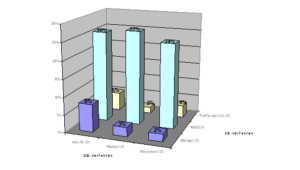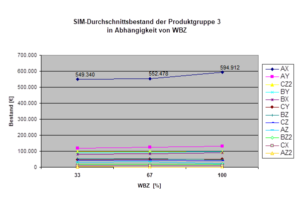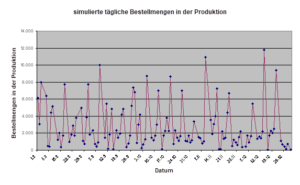by Felicitas Heid-Davignon1 and Martin Jürgens2
The corsetry and swimwear specialist Anita Dr. Helbig GmbH is known for the perfect fit of its products. The successful company worked together with Abels & Kemmner to create a perfect logistical fit. A very conservative overstocking analysis already revealed a stock reduction potential of 19%. The actual savings potential amounted to 26.3% according to targeted inventory simulations. The consulting project thus paid for itself in just four months at an inventory cost rate of 15%.
Anita Dr. Helbig GmbH manufactures and sells corsetry and swimwear in large cups and sizes and for the target groups of expectant and nursing mothers as well as women who have undergone breast surgery. For various reasons, the stock of finished goods has increased in recent years. In view of the acute situation, Abels & Kemmner was commissioned to achieve a systematic and lasting reduction in inventory costs through optimized scheduling. On the one hand, the high delivery readiness required by the market should be guaranteed and, on the other, the funds resulting from the inventory reduction should not be eaten up by increased resource consumption elsewhere in the value chain. It was therefore necessary to identify the “right adjusting screws” and then turn them in the “right direction” to the “optimum point”.
The initial situation
The reasons for the increase in finished goods inventory at Anita include
- The number of new items in model and/or color design increased, so that the total number of items to be stocked has increased, as the wheel of new and old items is turning faster and faster.
- In some cases, the inventory range for the core range was deliberately increased, while in other cases the earlier uncertainty of production deadlines necessitated higher safety stocks.
- Added to this are the high initial quantities of new products that are fully in stock on the delivery date.
Purchasing, production and logistics had already initiated a series of measures to improve the situation. The reliability of deadlines and delivery quantities in production had increased significantly in the previous months, which meant that the replenishment time of the finished goods warehouse could be reduced for a number of items in line with the reduced lead time through purchasing and production. Many decentralized finished goods warehouses have since been consolidated in a central shipping warehouse in Kufstein, so that the various European sales companies now only have smaller warehouses with access items and one warehouse is managed by the American sales company. Nevertheless, further optimization potential was expected, which was confirmed in the overstocking analysis that initiated the project.
Overstocking analysis
The two-day initial overstocking analysis in the Maternity product group (corsetry, swimwear and accessories for expectant and nursing mothers) revealed a very conservatively calculated inventory reduction potential of 19% with the same level of delivery readiness for items that can be influenced by replenishment. The actual savings potential, which was determined using detailed inventory and delivery readiness simulations, amounted to 43.7% in this product group with an average delivery readiness level of 96%.
Article classification
The first important step in identifying the right approaches to optimizing stock levels and delivery readiness is to structure the product range according to sales shares (“ABC”) and the predictability of requirements (“XYZ”) and to identify trends and seasonalities.
Iterative simulation
An iterative simulation of alternative forecasting methods for basic requirements and safety stock showed the influence of the individual input parameters or “adjusting screws” for each item class:
- Forecasting method
- Degree of readiness for delivery
- Lot size
- Covering time
- Replacement time
Influence of the forecasting method
As Anita had not previously used a scheduling optimization tool such as DISKOVER, it was important to decide how big an impact the “right” process choice would have on stock levels. If this influence reaches a corresponding order of magnitude, a scheduling tool like DISKOVER pays for itself very quickly.
The following graphic shows for the AX articles of a product group how often which of the nine simulated combinations of forecast procedure and safety stock procedure represents the optimum combination. It can be seen that in this article group, the process combination that was most frequently identified as the optimal one was the correct one for only 27% of the articles and that other process combinations had to be selected depending on the article!

Many ERP or merchandise management systems do not have different procedures for sales forecasting. The combination of the basic requirements method of “exponential smoothing 1st order” with the safety stock method of “moving MAD”, which is favored in some ERP systems as the standard method for forecasting, would be the optimal method in this case for only 26% of items. The result would be far too high stock levels with insufficient delivery readiness. If the complete article group is calculated with only one process combination, the average stock levels are more than twice as high, depending on the selected process combination
If the complete article group is calculated with only one process combination, the average stock levels are more than twice as high as with the article-specific optimization of the process combinations, depending on the selected process combination.
Influence of the degree of readiness to deliver
The target delivery readiness level specified by the company – ultimately determined by customer requirements – plays a key role in determining the level of inventories. For example, it was determined how much inventory a target delivery readiness level of 99% for the prostheses in the Anita Care product group costs and whether this can be achieved. In return, the increased costs for increasing the degree of readiness for delivery could be recouped several times over by reducing the target degree of readiness for delivery to 90% for items with sporadic Z or Z2 consumption behavior. Depending on the constellation, this may even result in sales growth in the medium term.
Influence of the batch size
The often high influence of the batch size on the inventory situation was not confirmed by the simulation calculations here. This means that the wrong adjustments would have been made by reducing the batch size. This put an end to a recurring discussion about the sense and benefits of batch size reduction in production.
Influence of the covering time
The Anita Maternity product group has a high proportion of AX articles. It was worth making an effort here to shorten the time it takes to cover up. The putaway time indicates how long the planned stock should last after the goods arrive from production until a new delivery of goods arrives. This more frequent planning of articles naturally means more work for the planners and production receives a higher number of production orders. However, as the simulation showed that this shortening of the stocking time is only worthwhile for AX articles with regular, almost constant consumption behavior, a simulation of the order proposals over time was generated for this article class. This proved that the smaller order batch sizes resulting from the shorter covering time for AX articles would not cause any problems for production. In this product group alone, this meant a reduction of around € 90,000 in the average stock of AX articles with a 10-day reduction in stocking time.
Simulated daily order quantities in production

The replenishment time or lead time (of purchasing and production) is an important factor which, in addition to the batch size, determines whether an item can be produced purely to order or not. The throughput time in bodice production is relatively high due to the difficult color matching with many different materials, the high proportion of manual work when processing lace and the special molding process. In the textile and clothing industry, the replenishment time and lead time is therefore specified in weeks and not days. A shortened replenishment time can be achieved through order-neutral advance planning. The replenishment time in DISKOVER, which is very finely divided into lead time, delivery time, safety time and goods receipt processing time, was gradually shortened in the simulation. While the replenishment lead time for AX items in one product group would have had to be reduced to 50% in order to achieve recognizable inventory reduction effects, the AX items in another product group reacted more sensitively to a reduction in replenishment lead time. However, the simulation also showed that a reduction in replenishment time in this product group by more than 30% no longer has any significant effect on stock levels.

Conclusion
The delivery readiness levels in the various product groups can be increased to 94 or 99%. This is accompanied by an average stock reduction of 26.3% across the 4 product groups for items that can be influenced on a discretionary basis. If the actual delivery readiness level remained the same, the inventory reduction potential would be as high as 49.8%. The amortization period of the consulting project, which extended over approx. 4 months for the 4 product groups, was also only 4 months with an inventory cost rate of 15%.
Customers expect “UniqueBodyWear” with a perfect fit from Anita. The company has now tailored a perfect logistical fit for itself in collaboration with Abels & Kemmner.
About Anita
As a specialist supplier of corsetry, swimwear, e.g. also for expectant and nursing mothers or special medical products for the aftercare of breast operations, Anita forms a competent, internationally active network of 20 individual companies with a total of approx. 1,100 employees and an annual turnover of approx. 70 million euros. The share of sales outside the core markets of Germany and Austria is already well over 50% and is rising sharply. Sales are preferably handled by the company’s own subsidiaries, in some cases via exclusive importers. In the global market, the Group enjoys an excellent reputation as a niche provider of high-quality specialty bodices and can count itself among the most entrepreneurially successful companies in the clothing industry.
The company’s own production sites are located in Germany, Austria, Portugal, the Czech Republic and the Far East. In addition to sample production, practically all prefabrication takes place at the Brannenburg site. The highly elastic materials used place special demands on the cutting of the parts in order to achieve a good fit. Cutting to size is therefore a core competence in the production process. This and the technical complexity of cutting on a cutter line mean that this work step is largely concentrated at the Brannenburg site.
The company sells a wide range of products, which is reinforced by the wide range of sizes that it serves and for which the company is known on the market. Four product ranges are sold in the corsetry segment, which differ in terms of their target groups, their demand structure, their contribution margins and the dynamics of fashion changes (Care; Maternity; Classics; Rosa Faia). There are also bathing collections for the same target groups, which are produced to pre-order.
1 Felicitas Heid-Davignon is Head of Logistics at Anita Dr. Helbig GmbH in Brannenburg.
2 Martin Jürgens is Senior Consultant at Abels & Kemmner

